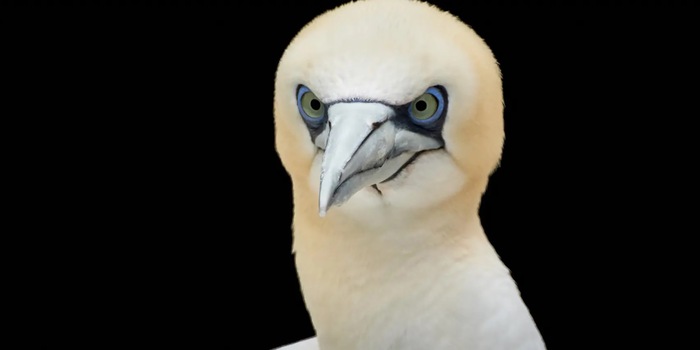
Bird flu colours irises black
A highly pathogenic variant of the H5N1 bird flu virus is eating its way through bird populations worldwide. Survivors can possibly be recognised by their discoloured eyes.
A highly contagious form of the H5N1 bird flu virus has been raging through bird populations worldwide since at least 2021. Seabirds are particularly affected: hundreds of thousands or perhaps even millions of birds died in 2022 alone; some species are now threatened. In Europe, gulls, terns and gannets, which nest on Heligoland, for example, have been particularly hard hit. An as yet unpublished study by Jude Lane from the British Royal Society for the Protection of Birds and her team on the bioRxiv suggests how scientists could recognise surviving gannets in the future: The irises of the birds may have turned completely black as a result of the infection, whereas they are light-coloured in uninfected specimens.
Such birds have been observed in various affected breeding colonies in the UK, France, Canada and Germany. Lane and co therefore examined tissue samples from 18 gannets with normal or black iris colouration that they collected on Bass Rock. The rock is home to one of the world's largest congregations of gannets.
The blood of eight animals was found to contain antibodies against H5N1, meaning the animals had been infected. And seven of the eight individuals had the altered iris, while the irises of the uninfected animals were normal in colour. However, it is unclear whether this discolouration is permanent or will return. This will be the aim of a further study, as will the question of whether and for how long the antibodies persist in the animals. This could then make it possible to predict how badly the colonies will be affected by this H5N1 variant in the future and how the populations will recover.
The survival rate of around 150,000 gannets on Bass Rock off the east coast of Scotland was over 40 per cent below the long-term average between 2021 and 2022. Certain species of skua were hit so hard that various ornithologists fear they could now be threatened with extinction. Terns, on the other hand, abandoned their clutches in 2022, which is why the breeding season was almost completely cancelled. As seabirds often only come ashore to breed and spend a large part of their lives at sea, it is unclear how badly the pandemic has affected the overall population. Some figures may not be available until 2023, when the breeding season begins.
In the meantime, the pandemic has spread as far as South America and it is only a matter of time before the large colonies in Antarctic waters are reached. However, not only seabirds are affected, but also other species such as cranes and birds of prey. The latter eat the carcasses of dead birds and become infected. In the USA, for example, 20 of the endangered California condors died from the disease, which can also affect mammals. In Peru, hundreds of sea lions, which had probably also eaten dead or weakened seabirds, died.
Spectrum of science
We are partners of Spektrum der Wissenschaft and want to make well-founded information more accessible to you. Follow Spektrum der Wissenschaft if you like the articles.
[[small:]]
Cover image: © Thomas Marx / Getty Images / iStock (detail) This gannet still shows the normal colouring of the eyes; recovered birds have completely black eyes.
Experts from science and research report on the latest findings in their fields – competent, authentic and comprehensible.